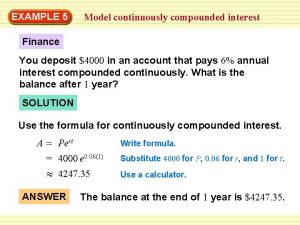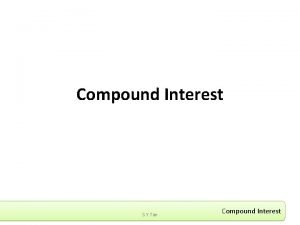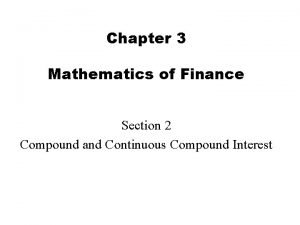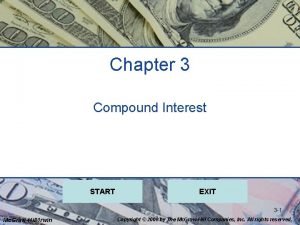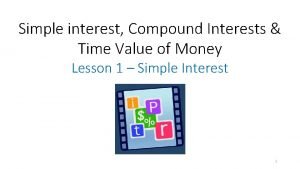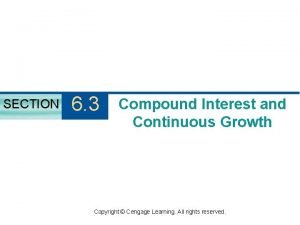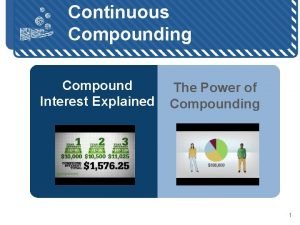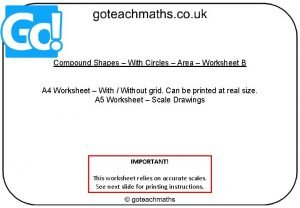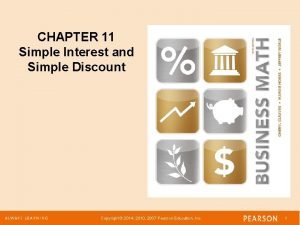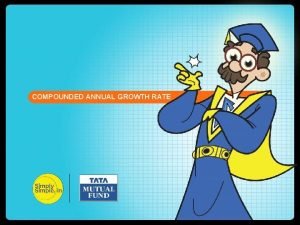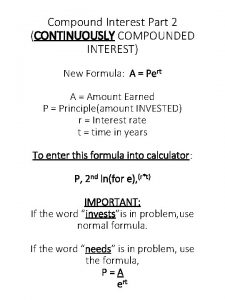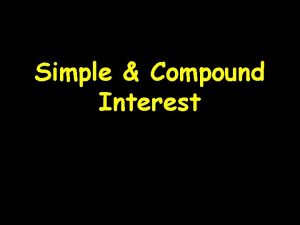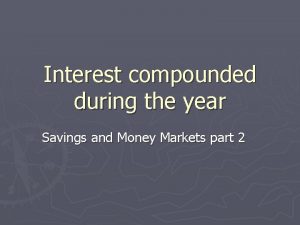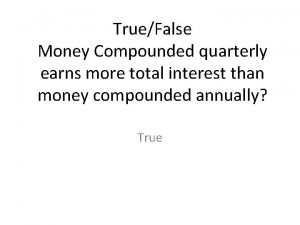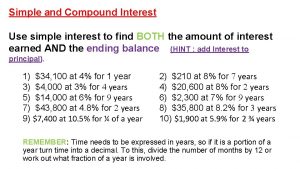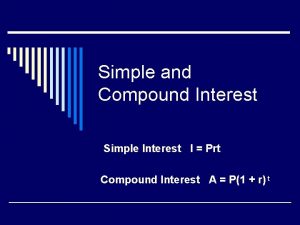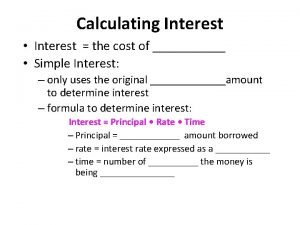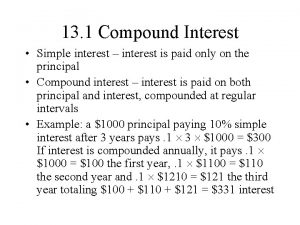Technologies Project Simple Interest and Compounded Interest Alex


















- Slides: 18

Technologies Project Simple Interest and Compounded Interest Alex Perlak

First, let’s define interest!! ● Interest can best be defined as money being paid a particular rate in a standard time periods over a period of time. Interest the extra money earned, or the difference from the initial principal and the accumulated amount in the account. ● Many things earn interest ○ ○ ○ Bank accounts Loans Certificate of deposit (CD), etc… ● There are two main types of interest that can be calculated ○ ○ Simple Interest Compounded Interest

Simple Interest Simple interest is the amount of money earned of the principal amount alone. We use the formula: A= P(1+rt) A= Accumulated Amount P= Principal r= Rate t= Time

Compound Interest can best be explained by saying interest is earn on the principal as well as the interest from the previous term. Compound interest can be found in bank deposits and credit cards. We use the formula: A = P (1 + r/n) (nt) A= Accumulated Amount P= Principal r= rate t= time n= number of times compounded in a period of time

Compound Values ● Yearly We use these value to show ● Semi-annually n=2 times per year interest ● Quarterly n=4 compounded. ● Monthly ● Weekly ● Daily n=1 many is n=12 n=52 n=365

Interest on Interest can be calculated by taking the difference between Compound Interest and Simple Interest given the same variables. Let’s go back to Desmos and find the interest on interest for example #2.

Applying the Formula Example #1: Calculate the simple interest on a $1000 investment, with a rate of 6. 5% over 3 years. First, let's identify the variables: A: ? ? ? (this is what we’re solving for) P: $1000 (the initial amount invested) r: . 065 (our rate, and don’t forget to convert the percentage to a decimal) t : 3 (the investment is 3 years long

Applying the Formula (cont. ) Now let’s sub in the values: A=P(1+rt) A: ? ? ? P: 1000 A=1000 (1+(. 065)(3)) r: . 065 t: 3 Now just solve A=1000 (1+. 195) A=1000 (1. 195) A= 1195

Wrapping up the problem A= 1195 Yes, we have solved for A, however, we are not finished with the problem. “Calculate the simple intereston a $1000 investment, with a rate of 6. 5% over 3 years. ” We now need to solve for the simple interest, to do this, follow the formula below: A-P (Accumulated Amount - Principle Value) 1195 -1000= ? ? ? The answer is $195 in simple interest

Now let’s use Desmos to Find “A” Start by accessing Desmos using the link desmos. com and click the tab “Start Graphing” in the top right corner.

Applying the Formula Example #2: Jasper decide to start a college fund on his 12 th birthday. He plans to invest $3000 in a bank with a 5. 75% interest rate compounded semiannually. He plans to take the money out of the account on his 18 th birthday. Calculate the Accumulated amount in the fund when Jasper turns 18 and the amount of interest earned on the investment. A= ? ? ? (We are solving for this) investment) r=. 0575 (rate in decimal form) P= $3000 (initial t= 6 years (18 -12) n= 2 (semi=annually means twice, or two times a year

Applying the Formula A= ? ? P= 3000 r=. 0575 A = P (1 + r/n) (nt) A= 3000 (1+(. 0575/2) (2)(6) A= 3000 (1. 02875) (12) A= 3000 (1. 405135) A= 4215. 41 t=6 n=2

Applying the Formula We come up with A= $4215. 41 Remember, to find the amount of interest earned, we take the difference of Accumulated Amount and Principle. $4215. 41 -$3000= $1215. 41

Now let’s use Desmos to Find “A” Start by accessing Desmos using the link desmos. com.

Compare Using Desmos and the previos example (Example #2), computate the Simple Interest and compare it to the Compound Interest.

Compare https: //beamery. com/blog/compounding-interest-of-employer-branding

Practice Problem Now that we know a little about both forms of interest, let’s put it together in one example and show the relationships between the two. 1. Andrea is saving up for a new car. She is wondering which is better, to invest with simple interest or compounded. She is planning on investing $6500. Both accounts allow for an interest rate of 8%. Andrea will be keeping this money in the bank for 7 years. a. Calculate the simple interest b. Calculate the compound interest if the account was compounded yearly c. Find the Interest on Interest

Additional Practice Problems 2. Joey wants to invest $3000 in a CD that earns 2. 4% compounded monthly over 36 months. How much will he earn at the end of the investment? 3 a. How much interest will Suzie earn on a $1000 investment with an interest rate of 7. 5% over 3 years? 3 b. Would Suzie earn more if she invests $950 with the same interest rate and over the same amount of time, but compounded quarterly? 4. Frank’s brother will either give Frank $6000 in an annuity fund that pays 5% semiannually for 10 years, or give Frank $10000 in 10 years. Which should Frank choose to receive the most money from his brother?
 Pert formula compound interest
Pert formula compound interest How to find the discount factor
How to find the discount factor How to calculate continuous compound interest
How to calculate continuous compound interest Interest rate compounded annually
Interest rate compounded annually Compounding daily formula
Compounding daily formula Compound interest multiplier
Compound interest multiplier Compound interest formula explained
Compound interest formula explained What is compounded continuously
What is compounded continuously Print on compounded shapes
Print on compounded shapes Find the area of each shape
Find the area of each shape Bankers rule
Bankers rule Simple discount example
Simple discount example Real vs nominal interest rate
Real vs nominal interest rate Simple present simple future
Simple present simple future Nominal rate of interest
Nominal rate of interest Past simple present simple future simple exercises
Past simple present simple future simple exercises Simple past simple present simple future
Simple past simple present simple future Past continuous present simple
Past continuous present simple Past simple future simple
Past simple future simple
